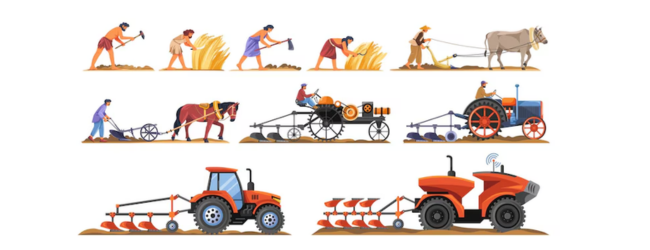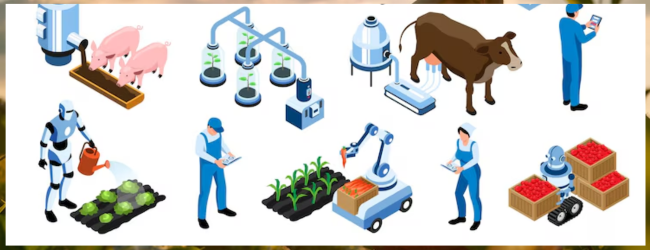Table of contents
- What is a Farming System?
- Major Types of Farming Systems in 2025
- 1. Subsistence Farming
- 2. Commercial Farming
- 3. Mixed Farming
- 4. Organic Farming
- 5. Shifting Cultivation (Also called Jhoom farming)
- 6. Intensive Farming
- 7. Extensive Farming
- 8. Precision Farming (Smart Agriculture)
- 9. Aquaponics & Hydroponics
- 10. Dryland Farming
- Farming Systems Comparison Table
- Benefits of Adopting the Right Farming System
- Conclusion
- Frequently Asked Questions (FAQs)
Farming is the backbone of any economy, especially in countries like India, where over 50% of the population is directly or indirectly dependent on agriculture. But not all farming is the same. There are different types of farming systems, each suited for specific climates, resources, and economic goals. In this blog, we’ll explore the most important farming systems in 2025, including traditional and modern types, explained in simple words that even a school student can understand!
What is a Farming System?

A farming system is a method or way of growing crops and raising animals that is influenced by environmental, economic, and social factors. It includes everything from land preparation, seed selection, irrigation, pest control, to harvest and marketing.
✅ Note: A good farming system helps increase food production while protecting the environment and farmer’s income.
Major Types of Farming Systems in 2025

Here are the most popular and widely used farming systems today:
1. Subsistence Farming
- Purpose: For personal or family consumption.
- Crops Grown: Wheat, rice, maize, vegetables.
- Common In: Rural India, Africa, Southeast Asia.
- Key Features:
- Small landholdings.
- Low or no use of machinery.
- Traditional farming techniques.
- Example: A farmer growing rice for his family without selling in the markets.
ALSO READ | Differences Between Subsistence Farming & Commercial Farming
2. Commercial Farming
- Purpose: To sell in markets and earn a profit.
- Crops Grown: Cotton, sugarcane, soybean, groundnut.
- Key Features:
- Large landholdings.
- Heavy use of fertilisers, pesticides, and machines.
- High-yield varieties are used.
- Example: Corporate-owned farms growing crops for export.
ALSO READ | Commercial Farming in India: Types, Advantages, Challenges & More
3. Mixed Farming
- What It Is: A Combination of crop farming and livestock.
- Example: A farmer growing wheat and raising cows or chickens.
- Benefits:
- Diversified income.
- Better use of resources.
- Organic manure from animals.
| Component | Example |
|---|---|
| Crop Farming | Wheat, barley |
| Animal Husbandry | Cattle, poultry, goats |
ALSO READ | What is Mixed Farming? Boosting Farm Resilience and Productivity
4. Organic Farming
- Purpose: Natural farming without synthetic chemicals.
- Techniques Used:
- Composting.
- Crop rotation.
- Use of cow dung and green manure.
- Pros:
- Environment-friendly.
- Healthy food.
- Stats: India has over 4.6 million hectares under organic cultivation (Source: APEDA, 2025).
ALSO READ | Principles of Organic Farming in 2025: 4 Pillars of Sustainable Agriculture
5. Shifting Cultivation (Also called Jhoom farming)
- Practised in: Hilly and tribal areas (e.g., North-East India).
- How It Works:
- Farmers clear a forest patch, burn it, and grow crops.
- After 2–3 years, they move to another area.
- Concern: Leads to deforestation and soil degradation.
ALSO READ | What is Shifting Agriculture? A Complete Guide to Ancient Farming Practice
6. Intensive Farming
- What It Means: Maximising output from small land.
- Needs: More labour, fertilisers, and irrigation.
- Goal: High yield per hectare.
- Common In: Punjab, Haryana, Uttar Pradesh.
ALSO READ | What is Intensive Subsistence Farming? Types and Practices
7. Extensive Farming
- What It Means: Using large land areas with minimal input.
- Features:
- Less use of labour and fertilisers.
- Mostly mechanised.
- Used In: USA, Australia.
ALSO READ | Extensive Farming: What is it, Practices, Investment, Benefits & More
8. Precision Farming (Smart Agriculture)
- Modern Tech Used:
- GPS, drones, IoT sensors.
- AI-based crop prediction.
- Benefits:
- Saves water, seeds, and fertilisers.
- Increases crop yield.
- Example: A farmer using drones to spray pesticides only where needed.
ALSO READ | Precision Farming in India: Technology, Benefits & Market Potential
9. Aquaponics & Hydroponics
- Aquaponics: Combines fish farming with soil-less plant cultivation.
- Hydroponics: Growing plants in water mixed with nutrients.
- Why It’s Trending:
- No soil required.
- Saves space—ideal for urban farming.
- It can be done indoors or on rooftops.
10. Dryland Farming
- Used in: Areas with low rainfall (< 750 mm annually).
- Challenges: Drought, water scarcity.
- Crops Grown: Millets, pulses, oilseeds.
- Technique: Water conservation methods like mulching and bundling.
ALSO READ | Dryland Farming: Cultivating Resilience in Water-Scarce Regions
Farming Systems Comparison Table
| Farming System | Purpose | Land Size | Tech Level | Example Crops/Activities |
|---|---|---|---|---|
| Subsistence Farming | Family needs | Small | Low | Rice, wheat |
| Commercial Farming | Market sale | Large | High | Cotton, sugarcane |
| Mixed Farming | Diversified | Medium | Moderate | Wheat + Dairy |
| Organic Farming | Health & Ecology | Small/Medium | Low-Moderate | Vegetables, spices |
| Precision Farming | Efficiency | Any | Very High | All high-value crops |
| Shifting Cultivation | Traditional | Small | Low | Rice, maize |
Benefits of Adopting the Right Farming System

- ✅ Increased productivity.
- ✅ Better soil health.
- ✅ More income sources.
- ✅ Climate adaptability.
- ✅ Reduced environmental damage.
Need Expert Guidance?
Starting a business can be challenging, but you don’t have to do it alone! At Boss Wallah, our 2,000+ business experts are ready to provide valuable insights and guidance. Whether you need help with marketing, finance, sourcing, or any other area of any business, our business experts are here to help you succeed
Confused about Which Business to Start?
Want to start your own business but unsure which one to choose? Explore Boss Wallah, where you’ll find 500+ courses by successful business owners, featuring practical, step-by-step guides on starting and growing various businesses.
Find your perfect business idea today
Conclusion
Choosing the right farming system in 2025 is not just about growing crops—it’s about sustainability, income, environment, and technology. From age-old subsistence methods to AI-powered smart farming, the variety is wide and growing fast. Farmers, students, and agri-entrepreneurs must understand these systems to make better agricultural decisions.
Frequently Asked Questions (FAQs)
The main types include subsistence farming, commercial farming, mixed farming, organic farming, precision farming, and shifting cultivation.
Mixed farming or organic farming is often best for small landholders due to lower investment and sustainable practices.
Subsistence farming is for personal use, while commercial farming is for selling in the market.
It uses technology like drones, GPS, and AI to optimize crop inputs and boost yield.
It promotes chemical-free agriculture, soil health, and eco-friendly practices.
Yes, especially in urban areas where land is limited. It requires investment but yields high returns.
It causes deforestation, soil erosion, and biodiversity loss.
It is the practice of farming in areas with low rainfall using water-saving techniques.
Yes, many farms use a mix, like organic + mixed farming or precision + commercial farming.
By analysing land size, climate, market demand, available resources, and goals.


